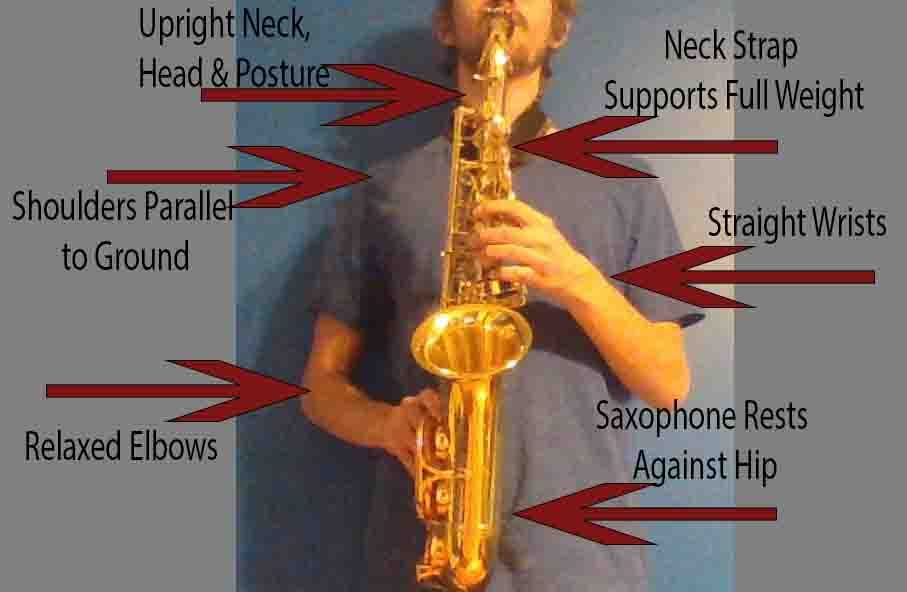Saxophone Posture – Everything You Need to Know
Posture is an important aspect of saxophone playing which is easy to ignore but has a significant impact on your ability to play. Correct posture allows for better airflow, better ease of technique, and ultimately a better sound.
Proper posture involves standing or sitting upright with the shoulders approximately parallel to the ground. The neck strap should be adjusted such that the mouthpiece comes directly to the mouth. The lower portion of the saxophone may rest on the waist or off to the side.
We’ll discuss the basics of posture here, and then address how this can vary depending on the type of saxophone that you’re playing.
Posture basics
Remaining upright
The most important facet is posture is to sit or stand upright and not slouch. Slouching restricts air flow, resulting in a pinched sound overall. You shouldn’t be rigidly upright, but you should nonetheless try to lift yourself up, straighten your spine, and pull your shoulders back. The neck should be straight, and the gaze should be level.
The saxophone mouthpiece should also come directly to your mouth. You shouldn’t have to move your head in any particular direction, nor should you have to bend your neck. You also shouldn’t have to physically lift the saxophone off of your body to have it reach your mouth. This can be taken care of through proper adjustment of the neck strap; the neck strap should be adjusted sufficiently high so that the mouthpiece naturally comes to your mouth without any effort on your part.
Keeping the shoulders parallel
The shoulders should be parallel to the ground. One of the most common mistakes that beginners make is the “sax shoulder”, where the saxophonist lifts their left shoulder up. The shoulders should be even with each other and relaxed.
Relaxed elbows and wrists
There is no particular need to forcibly lift any other part of the body. The elbows should be relaxed and at your sides. It is important to keep the wrists straight, as bending them causes strain (for a more detailed discussion of this point, see our guide on hand position).
Also, keep in mind that the position of the elbow affects the position of the shoulder. Lifting the left elbow can cause the left shoulder to be raised, resulting in the “sax shoulder.”
Should the saxophone be in front or to the side?
One common question is whether it is better to hold the saxophone in front of you or off to the side. The answer to this depends on the type of saxophone. It is better practice to hold a saxophone in front of you provided that it is an alto or soprano saxophone. However, you have to be of a reasonable height in order to do this. If you aren’t tall enough to hold an alto saxophone in front of you, no worries; it is better practice if you are able to do it, but it won’t hinder your playing to hold it to your side.
Tenor and bari saxes are too large to be held in front, and therefore must be held off to the right side. If you happen to be an extraordinarily tall person, however, you might be able to hold the tenor saxophone in front of you. I personally cannot.
Holding the saxophone in front is slightly better because it is easier; the saxophone can be balanced against the body with no effort from the musician whatsoever. Saxophonists who hold their instrument to the side will need to use their right arm to keep it in place. This is fine, but not as optimal.
Standing posture
Standing posture and sitting posture are not entirely identical and are worth addressing separately.
You may often be standing for solos and some live performances, and it is important to make sure that you are standing in a way that makes playing easy.
Consider the way that you are arranging your lower body. You should be able to easily stay upright without falling over. The simplest way to do this is to stand with your feet at shoulder-width apart and at a 90-degree angle. Both of your feet should be directly under your shoulders.
It is also acceptable to stand with both your feet facing forward at about shoulder-width apart. However, this may be more difficult for longer performances. I recommend finding the position which you find most comfortable and most stable for your feet.
Also, make sure that you do not lock your knees. They should be bent ever so slightly. Locking your knees restricts blood flow to your legs, and can result in you falling over – not a good thing to have happen during a performance.
Balance points while standing
The job of the neck strap is to hold the weight of the saxophone, but in order to stay upright the saxophone also needs to be balanced against the body.
Some saxophonists believe that the job of the hands is to balance the saxophone, but in actuality this is typically only done by the right hand (for straight soprano, tenor, and bari sax), and on the alto sax the hands don’t need to balance the saxophone at all.
By “balance points” I am simply referring to the points at which you balance the saxophone against your body. The alto saxophone has two balance points: one is the placement of the mouthpiece in the mouth, and the second is where the saxophone rests just above the waist, toward the right side. Note that you do not need to use your hands to keep the saxophone balanced against these points:
I recommend checking a few times during your practice to make sure that the saxophone is naturally balanced against your body. If you can keep your saxophone balanced as you see in the above picture, then holding your saxophone will be as effortless as possible. You can then bring your hands to the proper positions and the saxophone while being confident that you are not straining them in any way.
For tenor, bari, and soprano saxophones, you will likely need to use your right hand as a balance point. The soprano saxophone is not typically intended to be balanced against the body unless it is a curved soprano (in which case it may very well be possible). Tenor and bari saxes are generally too large to balance against the body unless the saxophonist is particularly tall.
The balance points of a saxophone serve as a good test of whether or not you are maintaining proper posture. If you are standing tall and upright, and the neck strap is adjusted such that the mouthpiece naturally goes to your mouth, then you will be able to keep the saxophone balanced against your body without having to use your hands. If you are not doing those things, then it will be much more difficult.
Sitting posture
Many facets of sitting posture are the same as standing posture. Remaining tall and upright is just as important, and you will still want to make sure that your shoulders are parallel to the floor. However, there are a few other considerations.
You want to make sure that you are sitting toward the front of your chair. Don’t sit back; you should literally be at the edge of your seat while you are playing. This is for two reasons. First, sitting back encourages slouching, which restricts air flow and is bad for your sound. Second, the chair can get in the way of your saxophone if you are sitting too far back. The saxophone should not be resting on the chair or on the legs.
Your feet should also be flat on the floor. Using a footrest or otherwise stretching one’s legs out encourages slouching, which once again restricts air flow.
Balance points while sitting
The points at which you balance the saxophone against your body when sitting should be essentially the same as when you are standing. However, the neck strap needs to be adjusted slightly lower when you are sitting compared to when you are standing. That is, the neck strap needs to be longer when you are sitting.
You’ll need to make sure that you can still balance the saxophone against your body without it touching the chair, which is slightly more difficult but should still be feasible. The balance point (i.e. the point at which the saxophone balances against the body) will be slightly lower than when you are standing, but you should still be able to find one.
As was the case for standing posture, the tenor and bari saxes require some pressure to be on the right thumb since they are held to the side. A straight soprano sax will inevitably require some pressure to be on the thumb.
How to improve posture
Practice with a mirror
Using a mirror while you practice is perhaps the simplest and most effective way to make sure that you are playing with proper posture. Watch yourself as you play, and try to notice any of the following:
- Whether you are upright
- Whether your shoulders are parallel
- Whether your hands and arms appear relaxed
If you see yourself not doing one or more of these, just make corrections and use the mirror to ensure that the issue is truly corrected.
Balance the saxophone against your body without using your hands
The second technique, as mentioned earlier, is to practice balancing your saxophone against your body. You may not be able to do this unless you play an alto sax or curved soprano sax. If you do play a saxophone which allows you to do this, though, then it is one of the best ways to make sure that you are not putting undue pressure on any part of your body.
All you have to do is practice getting into either of the following positions, depending on whether you are standing or sitting. The saxophone should be stable in this position; it shouldn’t be slipping off of your body.
If you do this occasionally throughout your practice session and make sure that you are not using your hands to shift the weight of the saxophone, then you should be set.
Conclusion
If posture isn’t something that you pay much attention to, it may be worthwhile to start doing so. Good posture is vital to a good sound, and one can gain a large payout from putting effort into it.
The key takeaway is to have a posture which is upright and stable while also being relaxed. Watch yourself in the mirror, don’t put any undue pressure on your hands or any other point of your body, and make sure that you can balance the saxophone against your body without using your hands (assuming that you play a curved alto or curved soprano).
Do all of these things, and I am confident that your posture will be impeccable.







